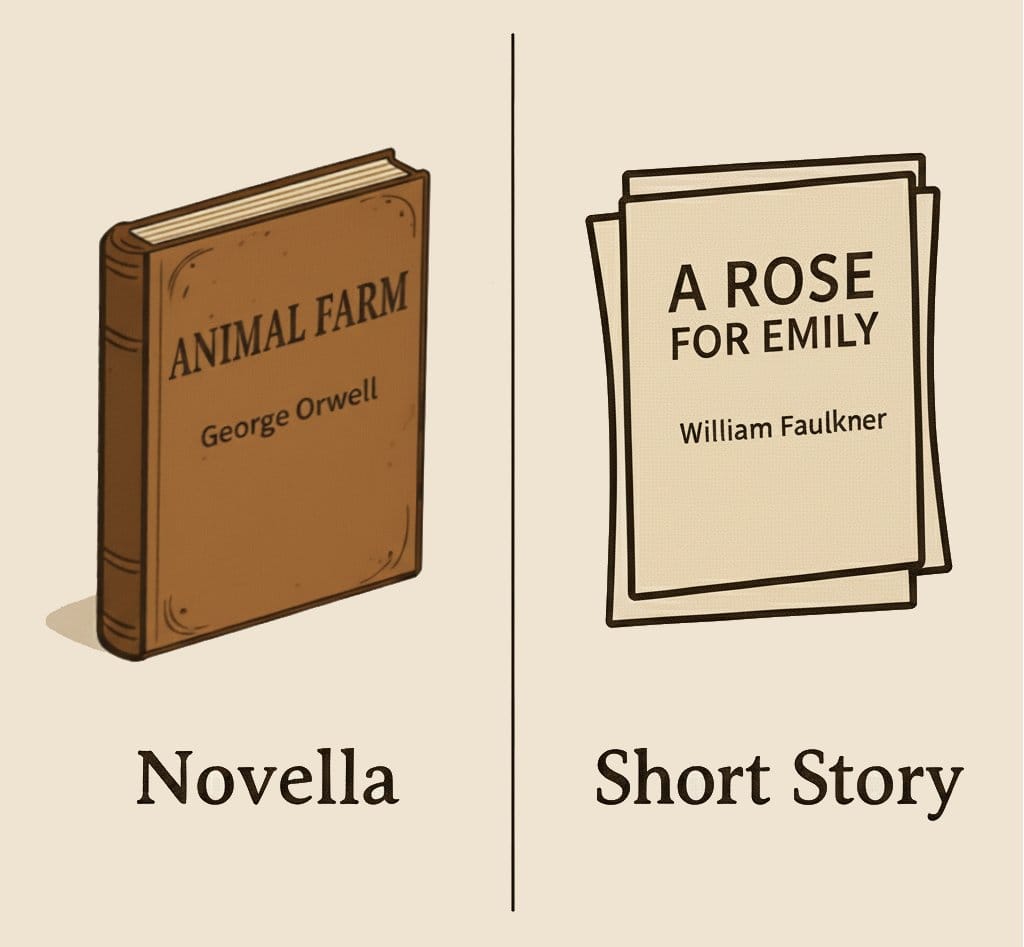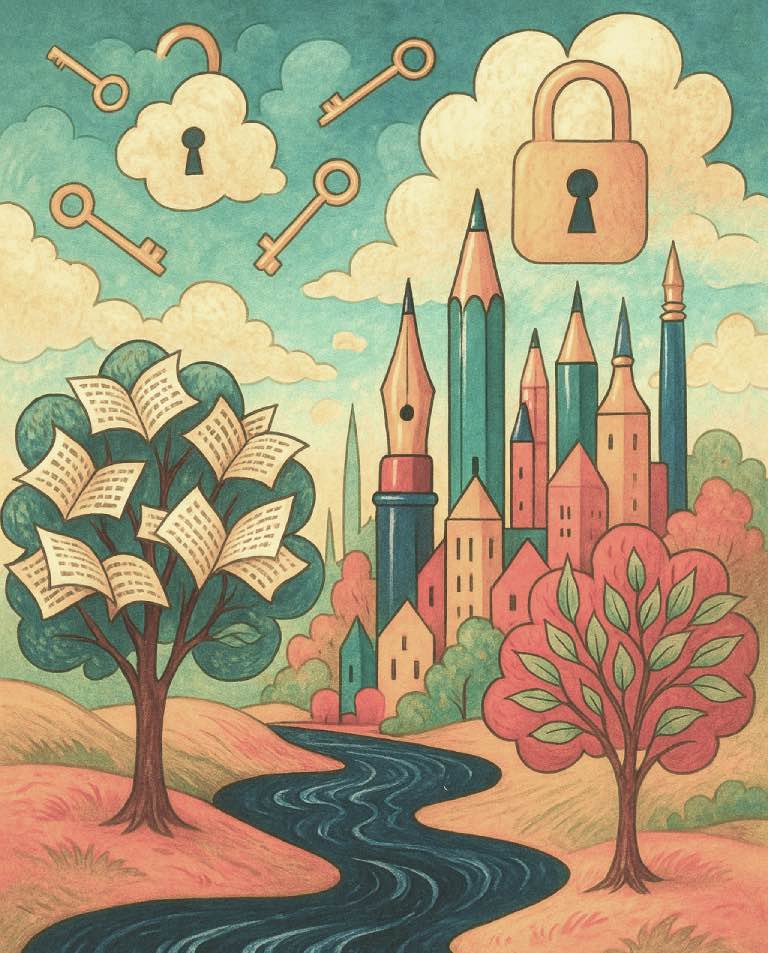When considering the distinction between short story and novella, word count remains the most reliable benchmark. In literary contexts, short stories typically span from about 1,000 to 10,000 words, though some reach as much as 15,000 words, particularly in earlier publications. Novellas, meanwhile, usually fall between approximately 10,000 and 40,000 words. More precisely, many literary-industry references and academic definitions position the novella within a tighter band of roughly 17,500 to 40,000 words.
Between these two sits the often-overlooked category of the novelette. This term usually refers to works between 7,500 and 17,500 words. It highlights how fluid the categories can be, since the novelette overlaps with both short stories at the lower end and novellas at the higher end. Though the categories offer guidance, they are conventions rather than immutable laws.
Is 100 Pages a Novella?
A book of around 100 pages is most often classified as a novella. Although page counts can shift depending on font and formatting, a work of this size generally falls between the concision of a short story and the breadth of a novel. It provides room for extended conflict and character development while retaining the cohesion that marks shorter fiction.
Measured in words, 100 pages usually amounts to roughly 25,000, which sits squarely in the accepted range for novellas. This makes it easier to see why such works are distinguished from short stories, which are rarely longer than 10,000 words, and from novels, which typically begin at 40,000 words or more. The page count therefore acts as a practical indicator for readers trying to visualize the scale of each form.
Classic works reinforce this boundary. George Orwell’s Animal Farm (1945) and Franz Kafka’s The Metamorphosis (1915), both often published around the hundred-page mark, show how a novella can sustain allegory and psychological depth without demanding the length of a full novel. The endurance of such works confirms the novella’s place as a distinct literary form with its own balance of brevity and substance.
What is Considered a Short Story?
A short story is most often defined as prose fiction that can be read in a single sitting, rarely exceeding 10,000 words. Its brevity sets natural limits on scope, making the form ideal for a concentrated treatment of a single event, mood, or moment in a character’s life.
Because the scale is so compressed, every word must serve the whole. Short stories usually avoid sprawling plots or a wide cast of characters and instead sharpen focus on one dominant impression. The unity that results gives the form its distinct power and intensity.
Flash Fiction and Microfiction
Within the short story category exists an even smaller form. Flash fiction typically stays under 1,000 words and achieves impact through suggestion and omission. Microfiction can be briefer still, sometimes distilled into only a few sentences. A famous example often cited is the six-word story “For sale: baby shoes, never worn.” Though long attributed to Ernest Hemingway, scholars have shown the connection is anecdotal rather than documented. Regardless of its origin, the piece has become emblematic of how narrative force can be compressed into the smallest possible space.
Is 10,000 Words a Short Story or a Novella?
A piece of fiction that reaches 10,000 words sits in a transitional zone. It stretches beyond the length of most short stories yet remains short of the scale expected of a novella. Because of this, the classification often depends on context rather than a strict rule.
In most literary references, novellas begin at roughly 17,500 words, leaving a 10,000-word work within the upper tier of short stories. Editors and anthologies may describe it as a “long short story,” especially when the piece maintains the concentrated effect associated with the form.
Practical usage, however, can vary. Some awards or journals apply narrower word-count limits, while others adopt broader definitions. In many cases, publishers decide on the label that best suits the work’s presentation, showing that while word counts provide guidance, interpretation remains flexible.
Structural Distinctions Between the Three Forms
The Short Story
Short stories thrive on concision. They typically present a limited number of characters, one central conflict, and a single perspective. The form favors brevity of description and economy of plot, producing a concentrated effect that often hinges on a striking conclusion or twist.
The Novella
Novellas, by contrast, have the space to develop characters with greater depth and to explore more sustained conflict. They may contain multiple scenes or a subplot but still maintain focus and unity. Many novellas are written with the intention of being read in one sitting, yet they provide more texture than short stories. Works such as Robert Louis Stevenson’s Strange Case of Dr Jekyll and Mr Hyde (1886) and Joseph Conrad’s Heart of Darkness (1899) exemplify the form.
The Novel
Novels extend beyond 40,000 words, though most contemporary works range between 80,000 and 120,000 words. The greater length enables expansive plots, interwoven subplots, multiple character arcs, and elaborate worldbuilding. Jane Austen’s Pride and Prejudice (1813) and F. Scott Fitzgerald’s The Great Gatsby (1925) both fall within the typical length for novels and illustrate how this scale supports layered storytelling. At the far extreme, works such as Leo Tolstoy’s War and Peace (1869) and George Eliot’s Middlemarch (1871–72) stretch to several hundred thousand words, demonstrating the upper possibilities of the form.
More Notable Examples
William Faulkner’s “A Rose for Emily” (1930) is a frequently cited short story, compact enough to fit in a single magazine issue yet powerful in its exploration of memory, tradition, and secrecy in a Southern town. Other well-known short stories include James Joyce’s “The Dead” (1914), which concludes his collection Dubliners with a meditation on love, mortality, and epiphany (though at over 15,000 words, it approaches the upper boundary of the short story form), and Charlotte Perkins Gilman’s “The Yellow Wallpaper” (1892), whose psychological intensity and critique of confinement helped secure its place as a classic of the form.
Novellas, by contrast, occupy a middle ground that blends concision with development. While The Metamorphosis and Animal Farm are often used to illustrate this category, many other works also stand out. Thomas Mann’s Death in Venice (1912) compresses obsession and degeneration into just over a hundred pages, while Leo Tolstoy’s The Death of Ivan Ilyich (1886) demonstrates how the novella can hold both a private struggle and a philosophical reflection on mortality. More recently, Ian McEwan’s On Chesil Beach (2007) has shown how contemporary writers continue to use the form to probe intimate conflicts with precision.
Why Distinctions Matter
These categories carry significance for both writers and readers. Contests and literary magazines often impose strict word count limits for submissions, making it essential for writers to know whether a manuscript qualifies as a short story or a novella. Beyond eligibility, the label can guide how a work is edited, published, and marketed.
For readers, classification directs expectations. Physical appearance alone often signals whether a book is short or long, but length does not always translate neatly into category. A slim volume might still be considered a novel, and a work that looks like a novel in print could fall into the novella range by word count. These designations serve more as conventions than rigid rules, with page counts and word counts offering guidance rather than absolute boundaries.
From a creative standpoint, the distinctions also matter. The constraints of shorter or longer forms influence the kinds of stories that can be told; hence, they promote either compression or expansion. Word counts discipline narrative scope, character design, and thematic exploration, yet the elasticity of these categories grants writers the means to blur borders when their stories demand it.
Further Reading
What counts as a novella and a short story? on Reddit
List of novellas on Wikipedia
Bite-sized: 50 great short stories, chosen by Hilary Mantel, George Saunders and more by The Guardian




